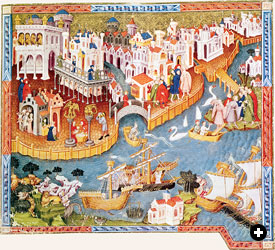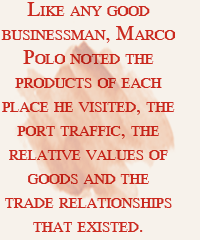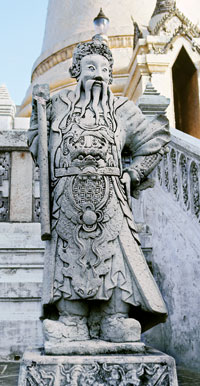
 arco Polo died in 1324, the year before Ibn Battuta set off, at age 21, from his native Tangier. Though they never met, Ibn Battuta almost certainly encountered people in his Indian Ocean travels who had seen Marco Polo and his entourage, for in 1292 Marco Polo sailed through the China Sea, the Malacca Strait and the Indian Ocean on his way home to Venice. His mission, on behalf of Yuan ruler Khubilai Khan, was to escort and deliver a bride for the Mongol Ilkhanid sultan Argun, then ruling the Islamic heartlands.
arco Polo died in 1324, the year before Ibn Battuta set off, at age 21, from his native Tangier. Though they never met, Ibn Battuta almost certainly encountered people in his Indian Ocean travels who had seen Marco Polo and his entourage, for in 1292 Marco Polo sailed through the China Sea, the Malacca Strait and the Indian Ocean on his way home to Venice. His mission, on behalf of Yuan ruler Khubilai Khan, was to escort and deliver a bride for the Mongol Ilkhanid sultan Argun, then ruling the Islamic heartlands.
 |
| Marco Polo was 17 years old when he set out with his father for China and 38 when he embarked to sail home to Venice. This woodcut portrait is a copy of an illustration from a “Gutenberg edition” of his Travels printed in 1477. KEN WELSH COLLECTION / BRIDGEMAN ART LIBRARY |
The number of islands in the Indian Ocean, Marco Polo wrote, is 12,700, “as shown by the maps and writings of the practiced seamen who ply in these waters.” He added the disclaimer: “There is no man in all the world who could tell the truth about all the islands of the Indies.” His account of the major ports, products and trade routes is remarkably accurate, despite some understandable geographical confusion and unreliable estimates of distances. Above all, he conveys a sense of wonder and enthusiasm for this world in which “everything is different”—a phrase he repeats frequently. He is alive to human, linguistic and zoological diversity, and this explains the great charm of his book.
He is also perhaps the first European writer since classical times to mention the monsoon: “I must tell you that it takes a full year to complete the voyage, setting out in winter and returning in summer. For only two winds blow in these seas, one that wafts them out and one that brings them back; and the former blows in winter, the latter in summer.”
His voyage began with a sailing from Zaitun (Quanzhou) to the kingdom of Champa in South Vietnam, a distance he estimates at 2400 kilometers (1500 mi). Champa was a main source of aloeswood, ‘ud in Arabic, much sought after throughout Islamic lands to this day as an aromatic, and ebony, used for making chessmen and pencases.
Although he did not visit Java, he mentions it is “the biggest island in the world,…a very rich island, producing pepper, nutmegs, spikenard, galingale, cubebs and cloves and all the precious spices…. It is visited by great numbers of ships and merchants who buy a great range of merchandise, reaping handsome profits and rich returns…. It is from this island that the merchants of Zaitun and Manzi [southern China] in general have derived and continue to derive a great part of their wealth, and this is the source of most of the spice that comes into the world’s markets.”
 Java did not, of course, produce all the spices he lists: the cloves and nutmegs came from the Moluccas; the pepper may have been imported from Malabar. But all were available in its markets.
Java did not, of course, produce all the spices he lists: the cloves and nutmegs came from the Moluccas; the pepper may have been imported from Malabar. But all were available in its markets.
Marco Polo says Khubilai Khan had never been able to conquer Java. In fact, he attacked the year after Marco’s visit, following attempts against Burma, Champa and Annam. The Yuan sought to impose their power at sea as well as on land, but they were dogged by failure, beginning with the destruction of the great fleet sent against Japan in 1274. Their persistent and costly attempts at naval domination nevertheless show their determination to control not only the overland routes to China, but the maritime ones as well—an ambition encouraged by Muslim traders in the Yuan empire, who would have welcomed the elimination of non-Muslim competition in Japan and South and Southeast Asia.
Marco Polo sailed from South Vietnam to the Malay Peninsula, where “gold is so plentiful that no one who did not see it could believe it. There are elephants and wild game in profusion.” There was also brazilwood, which produced a red dye for the textile industry and which Marco tried, unsuccessfully, to transplant to Venice.
 |
| Venice in the late 13th or early 14th century, where Marco Polo grew up in a merchant family. SNARK / ART RESOURCE |
He then sailed through the Strait of Malacca, which he is the first to describe, to Sumatra, which he calls “Java the Lesser.” This was, he wrote, divided into eight kingdoms, each with its own language. One of the kingdoms was “Ferlec”—probably Periak in northern Sumatra. There, he says, the people used to be Hindus, but have converted to Islam through contact with Muslim merchants. He adds that this was true only of the inhabitants of the city, the mountain people being cannibals. The process of Islamization—at the hands of traders from India and mainland Southeast Asia, rather than from Arabia—was just beginning: This is the earliest reference to a Muslim sultanate in the Indonesian archipelago. He spent five months in Samudra waiting for the northeast monsoon so he could continue his voyage west to Sri Lanka.
He estimates the circumference of Sri Lanka at 2400 miles, adding that it was once much bigger, measuring 3500, “as appears in the mariners’ charts of this sea.” He explains, “The north wind blows so strongly in these parts that it has submerged a great part of this island under the sea.” The reference to marine charts is reason to believe that they were used by Indian Ocean sailors; however, none have survived.
Then as now Sri Lanka was famous for precious stones, in particular rubies. The king owned a ruby the length of a man’s palm and the thickness of his arm, flawless “and glowing red like fire.” This royal ruby is also mentioned in the seventh voyage of Sindbad; Marco Polo says Khubilai Khan sent an embassy to purchase it, but the king would not part with it.
Marco Polo landed from Sri Lanka on the southeastern, or Coromandel, coast of India, and his long account of the country is filled with information on local customs, religion, dress and diet. He describes the pearl-fishing industry in the Gulf of Manaar and the importation of Arabian horses from Hormuz, Kais, Dhufar, Shihr and Aden. The king of Coromandel purchased an average of 2000 horses a year, paying a bit less than 250 grams of gold (about 8 oz) for the finest. As they did not survive long in the climate, the demand was constant.
 |
| So important a trading center was Hormuz in the late 12th century that Marco Polo passed through it twice, once on his overland journey to China and again on his sea voyage home. LES LIVRES DES MERVEILLES / BIBLIOTHEQUE NATIONALE / SNARK / ART RESOURCE |
Marco Polo had much to say about the thriving trade in ports like Kayal, Comorin, Quilon, Thana, Somnath and Cambay, all of which he visited. For several he gives the latitude by indicating the height of the Pole Star above the horizon, the same method used by Ahmad ibn Majid. These ports were linked to both China and the Mediterranean:
There is great abundance of pepper and also of ginger, besides cinnamon in plenty and other spices, turbit and coconuts. Buckrams are made here of the loveliest and most delicate texture in the world. In return, when merchants come here from overseas, they load their ships with brass, which they use as ballast, cloth of gold and silk, sandal, gold, silver, cloves, spikenard and other such spices that are not produced here…. Goods are exported to many parts. Those that go to Aden are carried thence to Alexandria.
To the northwest, in Gujarat, Marco Polo notes the region’s independence and its own form of Indo-Aryan speech; he is one of the few medieval travelers to remark on linguistic diversity. He mentions the famous cotton of Gujarat and the export of leather goods to Arabia and other countries: “Suffice it to say that in this kingdom are produced leather goods of more consummate workmanship than anywhere in the world and of higher value.” The ships that called at Cambay brought gold, silver and brass, exchanging them for leather goods, cotton textiles and indigo.
He then crossed the Indian Ocean to the island of Socotra, a Nestorian outpost off the coast of southern Arabia that still had an archbishop appointed from Baghdad. Socotra was famed in the Middle Ages for the export of “dragon’s blood,” an astringent resin used for treating wounds. The island also exported ambergris, salt fish and fine cotton cloth. Ships bound for Aden called here to trade and reprovision.
 Immediately after describing Socotra, Marco Polo gives a hearsay account of Madagascar, beyond which no one sails, he says, because of the strong southern current. (This was the current that led the Arab geographers too to believe that ships that sailed beyond Madagascar would be unable to return.) There, he says, ships come with cloth of gold and silks, trading for ivory and ambergris and other local products. Madagascar, he says, is also the home of the gryphon, and he says he talked to men who had actually seen it. It was not, as Europeans believed, a blend of bird and lion, but a true bird of colossal size: “They report that they are so huge and bulky that one of them can pounce on an elephant and carry it up to a great height in the air. Then it lets go, so that the elephant drops to earth and is smashed to pulp, whereupon the gryphon bird perches on the carcass and feeds at its ease.” He then says that the islanders call this bird the rukh—an old friend from the tales of the voyages of Sindbad.
Immediately after describing Socotra, Marco Polo gives a hearsay account of Madagascar, beyond which no one sails, he says, because of the strong southern current. (This was the current that led the Arab geographers too to believe that ships that sailed beyond Madagascar would be unable to return.) There, he says, ships come with cloth of gold and silks, trading for ivory and ambergris and other local products. Madagascar, he says, is also the home of the gryphon, and he says he talked to men who had actually seen it. It was not, as Europeans believed, a blend of bird and lion, but a true bird of colossal size: “They report that they are so huge and bulky that one of them can pounce on an elephant and carry it up to a great height in the air. Then it lets go, so that the elephant drops to earth and is smashed to pulp, whereupon the gryphon bird perches on the carcass and feeds at its ease.” He then says that the islanders call this bird the rukh—an old friend from the tales of the voyages of Sindbad.
After this excursus on East Africa, Marco Polo proceeded to Aden, “the port to which all the ships from India come.” He describes how ships transfer their cargoes to smaller boats in the harbor, “sail for seven days along a river” (presumably the Red Sea), and then transfer the goods to camel-back and send them overland on a 30-day trip to the Nile and thence to Alexandria and the Mediterranean.
He describes three other flourishing Arabian ports—Shihr, Dhufar and Qalhat, all exporting fine horses to India; Shihr and Dhufar also exported frankincense. He then crossed the Gulf to Hormuz, not the “New Hormuz” that Ibn Battuta saw on the island of Jarun, but the mainland town. Marco describes the system of ventilators (badgir) that funneled cool air into the interior of the houses and made life bearable.
 |
| This statue of Marco Polo stands in Bangkok. It depicts him dressed and whiskered as he may perhaps have been at the court of Khubilai Khan, whom he served for 17 years before returning to Venice. VICTOR MINCA / ART RESOURCE |
A number of other European travelers and missionaries took advantage of the pax mongolica to travel to the Far East in the early 14th century. Several of them, including Odoric of Pordenone, Fray Jordan Catalán de Sévérac and Fray Pascual de Vitoria, sailed home through the Indian Ocean. They wrote short accounts of their travels that supplement, but do not eclipse, Marco Polo’s. Nicolò dei Conti voyaged widely in the Indian Ocean between 1414 and 1439. His itinerary is remarkable: Baghdad–Hormuz–Qalhat–Cambay– Malabar–Madras–Malapur–Sumatra– Burma–Ava–Pegu–Java–Borneo– Champa–Quilon–Cochin–Calicut– Cambay again–Aden–Berbera–Jiddah– Makkah–Cairo–Venice. He spent nine months in Borneo and learned from traders of the existence of the far-off Moluccas, the Spice Islands that the early Arab geographers had known only as bilad manbit al-‘atar, “the country where the spices grow.” He is the first author to refer to the bird of paradise, species of which live only in New Guinea and adjacent islands and whose feathers were much prized by the Chinese and Ottoman Turks.
On his return to Europe, his caravan crossed with that of a Christian knight, Pero Tafur, near Mount Sinai. Nicolò told Pero Tafur that he had left home at 18, lost his inheritance, spent a year at the court of Tamerlane in Samarkand, then set off for India. In India, Nicolò claimed, he had been received by Prester John, “very graciously and [he] showed me many favors, and married me to the woman I now have with me, and she bore me these children.” Prester John, he said, was a great lord with 25 kings in his service, and he had sent two unsuccessful expeditions in search of the sources of the Nile.
On his return to Italy, Nicolò dictated his travels to the papal secretary and learned humanist Poggio Bracciolini, to whom we owe the survival of so many key works. He toned down his account, producing a short, informative report of his travels. Much of his geographical information was recorded by the Venetian Fra Mauro on his wonderful map of 1459, a map which, incidentally, clearly shows Africa as a peninsula. Yet Nicolò’s conversation in the desert with Pero Tafur shows the medieval side of this remarkable man, whose obsession with Prester John and the sources of the Nile was shared by the Portuguese and spurred them to undertake their punishing voyages.
Nicolò had been able to travel freely while Tamerlane was alive, but when Tamerlane’s empire crumbled after his death in 1404, the overland routes were no longer safe, and Nicolò was forced to return to Italy by sea. He was not the only one inconvenienced by the death of the Central Asian conqueror, nor was he the only one to turn to the sea.
 |
Historian and Arabist Paul Lunde studied at London University’s School of Oriental and African Studies and specializes in Islamic history and literature. He is the author of Islam: Culture, Faith and History. With Caroline Stone, he has translated Mas‘udi’s Meadows of Gold and—forthcoming this fall from Penguin—Travellers From the Arab World to the Lands of the North, a collection of travel accounts. Lunde is a longtime contributor to this magazine, with some 60 articles to his credit over the past 33 years, including special multi-article sections on Arabic-language printing and the history of the Silk Roads, and the theme issue “The Middle East and the Age of Discovery” (M/J 92). He lives in Seville and Cambridge, England, and is working on an Internet project to map pre-modern Eurasian cultural and intellectual exchanges. He can be reached at paullunde@hotmail.com. |
< Previous Story | Next Story >